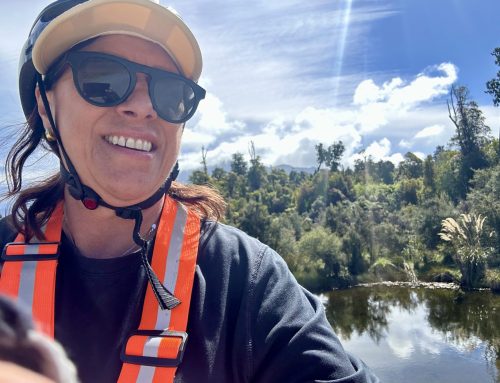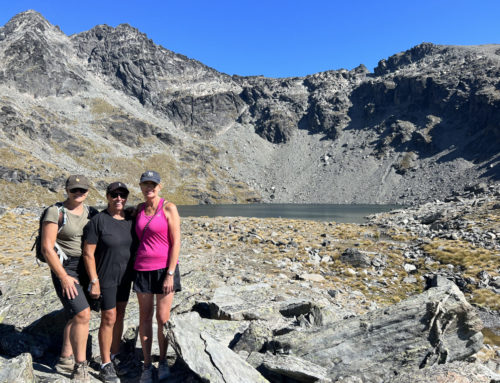‘The Milford Track has often been described as the ‘finest walk in the world’. It traverses spectacular landforms and vegetation. Such is the demand for this experience, places are strictly limited. A few “freedom walkers” are allowed, but most make the journey as we did guided by professionals such as the Ultimate Hikes team.

For me the ‘walk” began many weeks prior to the actual Milford Track adventure. To enjoy the experience you must have a reasonable level of fitness to complete the 58 kilometres (36 miles), 900 metre ascent, carrying a small pack over sometimes rough terrain. Not being incredibly fit I built up my walks to 8-12 kms a day including hill work and hoped it would be enough.
The Ultimate Hikes team provided a detailed list of what to bring and after a pre-departure briefing in Queenstown we set off on the bus for Te Anau. It’s about a 3.5 hour bus trip before catching a boat to the top of Lake Te Anau, the starting point of Milford track. It is a very short walk to Glade House which was our stop for the first night. Glade House provided good accommodation and the meals and facilities were of a good standard, as they were in all the wilderness lodges. Our party had the maximum of 50 walkers and 4 guides. They introduced us to the vegetation and wildlife in the area and briefed the team on what to expect on day two of the hike.



Up at first light, we began the 16 kilometres (10 miles), 200 metre climb. This part of the track follows the Clinton River up a glacial valley through spectacular beech forest. Lush vegetation and crystal clear water are everywhere. As we walked up the Clinton Valley the evidence of glacial action became more prominent with the rock walls towering up to 1,200 metres (4000 feet) on either side. It’s an awe inspiring sight with numerous waterfalls tumbling to the valley floor. The day concluded with a climb to Pompolona Lodge, our accommodation for the night. It’s the first “taste” of what was ahead.

The Fiordland area is famous for its forests, waterfalls and lakes. It’s no surprise rainfall is immense. Last year around 10 meters of rain fell in Milford Sound and during the night at Pompolona it rained heavily.
We set off early for what was regarded the toughest day of the walk, 15 kilometres (9 miles), a 700 metre ascent and a 900 metre descent. The waterfalls off the side of the glacial walls were even more numerous and spectacular which was a great reward for our exertion as we made our way to the head of the Clinton Valley. After around 2 hours of walking we arrived at Mintaro Hut to catch our breath and don our thermal gear for the climb over the Mackinnon Pass. The trees, ferns and mosses around Lake Mintaro look primeval and I found myself thinking the beech trees covered in ferns had been the role model for the “Ents” in Lord of the Rings. This thought quickly receded as we began the steep ascent up eleven “zig zags” that would take us up the pass. It’s hard work made bearable by the views as you ascend. Around half way up we came out of the beech forest into an alpine area with the vegetation changing completely to include beautiful alpine flowers. The views are just indescribable as these massive ice shaped landforms surround you and water tumbles off the granite cliffs.


Once at the top, you see Mackinnons Memorial built in 1912. The views into the neighbouring Arthur valley are breathtaking. Luckily for us the weather was reasonable so there was time for a quick hot drink before setting off to Pass Hut for lunch. The descent to the floor of the Arthur Valley was slow, stopping to fill my water bottle from a stream fed by the Jervois Glacier. Our guide had told us all the water on the track was pristine and drinkable, but this was the best. It was the nicest water I have ever consumed. Having reached the valley floor I foolishly thought I had broken the back of the day, however the last few kilometres were the hardest of the entire walk. The track is rough as you navigate glacial moraine and follow the river as it tumbles down the valley. Finally, Quintin Lodge came into sight. After removing our packs and having a short rest many us took a walk to the 580 metres (1904 feet) drop of the Sutherland Falls.


The final day was a gentle undulating walk, 21 kilometres (13.5 miles) to Sandfly. This part of the walk has a higher rainfall so the forest was even more lush. Massive beech trees, moss and ferns at every turn. There was also evidence of ‘tree avalanches” which occur when in heavy rainfall the beech trees are unable to maintain their grip on the steep granite slopes. The soil is shallow and the beech trees entangle their roots with their neighbours to provide stability, but when one falls often many go hence the “tree avalanche” phenomenon.


The track was good and we crossed well maintained swing bridges and passed many spectacular waterfalls. Mackay Falls and Giants Gate are standouts. The final stretch of the track took us around Lake Ada with one final stand of beech forest to the well named Sandfly Point. From here it was a 15 minute boat ride into the majestic Milford Sound and a celebratory dinner at our accommodation, Mitre Peak Lodge.
The next morning we sailed up Milford Sound to the Tasman Sea passing impossibly steep cliffs, mountains, dolphins playing in the water and of course many waterfalls. Most folk then bus the 5 hours back to Queenstown, however we decided to helicopter back. Again the terrain was just breathtaking and 30 minutes later we were at Queenstown airport and the end of a never to be forgotten adventure.






Leave A Comment